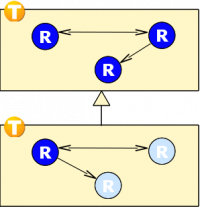Notice: this Wiki will be going read only early in 2024 and edits will no longer be possible. Please see: https://gitlab.eclipse.org/eclipsefdn/helpdesk/-/wikis/Wiki-shutdown-plan for the plan.
Difference between revisions of "OTJ Primer"
| Line 3: | Line 3: | ||
* If, on the other hand, you look for literature on the background of the concepts of Object Teams, the list of scientific [http://www.objectteams.org/publications publications] has all you need. From these, the following is the most comprehensive recent coverage of Object Teams: [http://www.objectteams.org/publications/#JAO07 A Precise Model for Contextual Roles: The Programming Language ObjectTeams/Java] -- (Journal Applied Ontology 2007) | * If, on the other hand, you look for literature on the background of the concepts of Object Teams, the list of scientific [http://www.objectteams.org/publications publications] has all you need. From these, the following is the most comprehensive recent coverage of Object Teams: [http://www.objectteams.org/publications/#JAO07 A Precise Model for Contextual Roles: The Programming Language ObjectTeams/Java] -- (Journal Applied Ontology 2007) | ||
| − | This page with its sub-pages tries to cover the middle ground, addressing readers who do want to learn the essential concepts of Object Teams without the burden of a detailed scientific discussion.}} | + | This page with its sub-pages tries to cover the middle ground, addressing readers who do want to learn the essential concepts of Object Teams without the burden of a detailed scientific discussion. |
| + | |||
| + | Throughout this text references into the [http://www.objectteams.org/def/1.3 OT/J Language Definition] are given like this (see {{otjld|0|}}), were the interested reader will find the detailed definitions.}} | ||
| + | |||
The programming language [[OTJ|OT/J]] introduces two '''new kinds of classes''' | The programming language [[OTJ|OT/J]] introduces two '''new kinds of classes''' | ||
* [[Image:Team_obj.gif]] '''Teams''' | * [[Image:Team_obj.gif]] '''Teams''' | ||
Revision as of 12:44, 8 July 2010
The programming language OT/J introduces two new kinds of classes
However, it is much more interesting to look at what happens between these things.
Here, OT/J introduces the following major relations:
Role Playing
Role classes/objects are playedBy base classes/objects. The communication between the two part objects is defined using
- callout method bindings for forwarding role-to-base
- callin method bindings for intercepting method calls base-to-role
Role Containment
Role classes/objects are contained in a team instance.
- Roles preferably communicate with other roles.
- Roles can be confined to their enclosing team to protect them against external access
- Data-flows between a team an its outside applies translation polymorphism to translate between roles and bases:
- sending a role object to the outside applies lowering (role-to-base translation)
- sending a base object into a team applies lifting (base-to-role translation)
- Team activation controls the enablement of callin bindings
→ Details on Role Containment ...
Team Inheritances
- A team class can be sub-classed including all its contained roles (similar to Java classes with inner classes)
- A sub-team can override any of its inherited roles (different from Java inner classes).
- An overriding role implicitly inherits from its overridden version.


